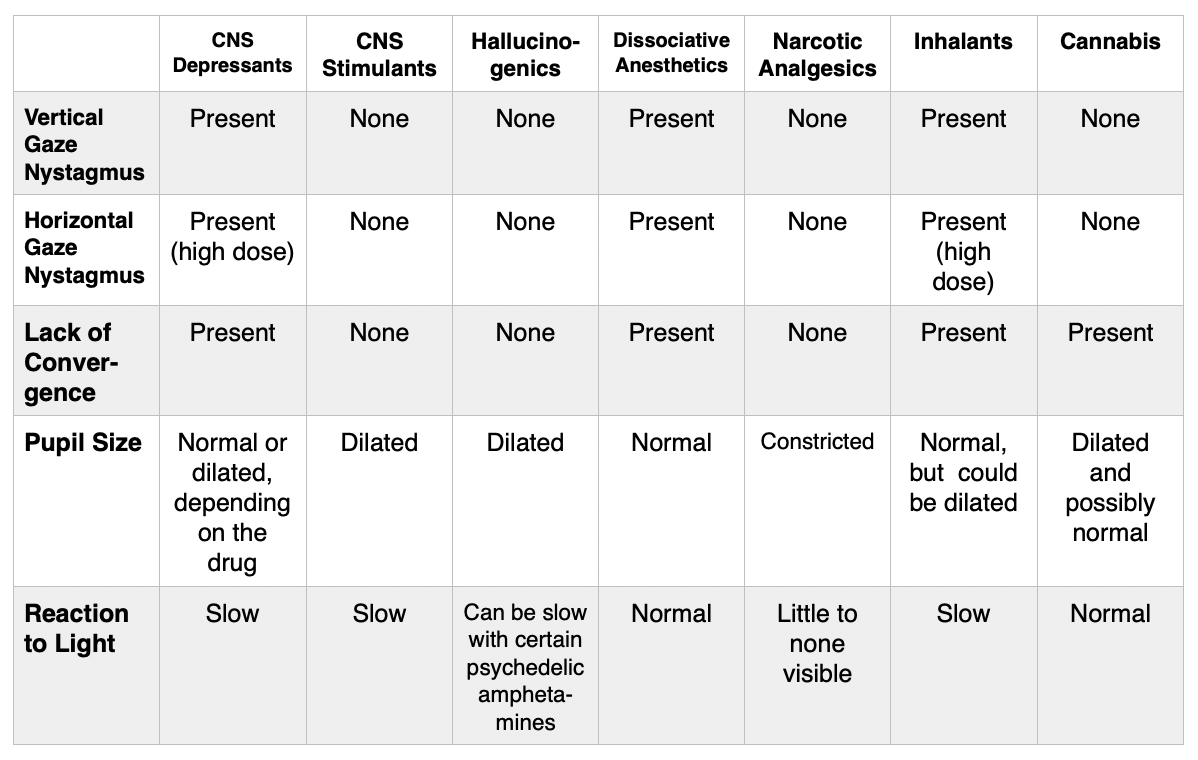Drugs and Oculomotor Testing

Have you ever wondered about the relationship between drugs and oculomotor testing? From time to time I was curious, but never looked into it until I received an email a few months ago from Ocular Data Systems asking if I could work with them on a project to provide online lessons regarding vestibular physiology and how to analyze nystagmus findings for law enforcement officers, prosecutors, and toxicologists.
It seemed like a unique opportunity, a Canadian physical therapist helping educate law enforcement officers, prosecutors, and toxicologist from the USA. What I did not realize until then is that there is a group of very highly trained non-medical professionals who perform oculomotor testing as well.
What other non-medical profession analyzes nystagmus?
In writing this post I did a brief Google search to see what professionals perform oculomotor testing and health care providers were the only results that came up on page 1 of my search.
What is not common knowledge is that Drug Recognition Experts, or DREs also perform oculomotor testing.
So, who are DREs? They are law enforcement officers with specialized training to recognize impairment in drivers under the influence of drugs and alcohol. Traditionally, officers and prosecutors had difficulty identifying and prosecuting drug impaired drivers. Fortunately, the Drug Evaluation and Classification (DEC) was developed by combining basic medical knowledge about drug pharmacodynamics with validated psychomotor tests that the DRE use. In addition, DREs also educate prosecutors and toxicologists on the DRE process and the drug categories.
From their standardized 12 step evaluation, which includes observing for nystagmus, ocular convergence, pupil size and pupil reaction to light, the DREs are able to not only determine if someone is under the influence of drugs and/or alcohol, but can determine the category of drug in their system.
Drugs and oculomotor testing
Here is a summary of the ocular findings consistent with certain drug categories:

Again, these findings are use in conjunction with other findings (i.e. blood pressure, muscle tone, balance, lab tests, general observations) in their 12 step assessment.
Does alcohol cause nystagmus?
Alcohol can certainly cause nystagmus which is referred to alcohol gaze nystagmus (AGN). The interesting thing I learned over the past few months is there is a linear relation between blood alcohol concentration (BAC) and the point where the nystagmus starts with horizontal gaze.
A person's BAC can be estimated by subtracting the angle of onset from 50. So, to determine the BAC if someone had an angle of onset of 35o (the nystagmus started when they looked 35o to one side) they should have an BAC of approximately 0.15. Or, 0.13-0.17 as the margin of error is approximately 0.02.
Drugs other than alcohol, however, do not have a linear relationship, but as seen above can cause horizontal gaze nystagmus and in large doses vertical gaze nystagmus. No known drug, however, causes vertical gaze nystagmus without first causing horizontal gaze nystagmus.
Note: Alcohol can affect the functioning of the brain. It can also affect the chemical balance of the inner ear. To find out more about the temporary effects of alcohol on the inner ear click HERE.
Some stats to drive home
- According to the 2016 National Survey of Drug Use and Health, an estimated 28.6 million Americans aged 12 and older were illicit drug users.
- In the USA, among drug-tested fatally-injured drivers in 2016, 38% tested positive for some form of marijuana, 16% tested positive for opioids, and 4% tested positive for both marijuana and opioids. [source]
- In the USA in 2016, 44% of fatally-injured drivers with known results tested positive for drugs, up from 28% just 10 years prior. [source]
I hope that you found this an interesting read about drugs, alcohol and oculomotor testing, along with a sober reminder to do what we can to keep our roads safe.


